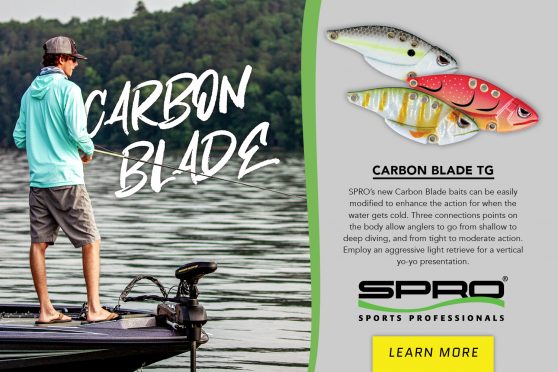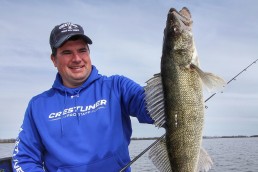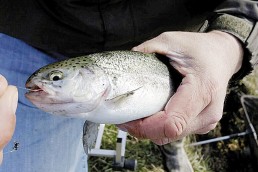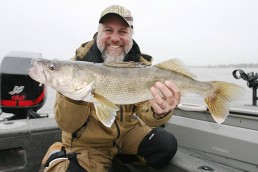Power Rigging Live Bait for Tentative Walleyes
SHARE THIS POST
Live bait is a critical component to catching walleyes. Even with the advent of soft plastics and walleye anglers having more confidence with artificial baits, there’s still a time and place for live baits. With today’s presentations that have replaced live baits with soft plastics when rigging and jigging, the fallback to a live bait often correlates with finesse and triggering fish that won’t commit to aggressive presentations. And when you need to sit on a spot, live baits still shine.
 The dependency of using live baits can vary from angler to angler and lake to lake. Some fisheries just seem to require these baits if fish are going to be caught with consistency. Typically, if you have extremely clear water, low-population densities of fish and an abundance of forage, the live baits will often trump everything else.
The dependency of using live baits can vary from angler to angler and lake to lake. Some fisheries just seem to require these baits if fish are going to be caught with consistency. Typically, if you have extremely clear water, low-population densities of fish and an abundance of forage, the live baits will often trump everything else.
With my own fishing, live baits can be a productive option. I often start out using soft plastics and cover the water. Typically, you can find fish and catch the easier ones with soft plastics or artificial baits before eventually wearing out your welcome. After you’ve been on a spot and have removed the susceptible fish and have decreased the competition among the remaining fish, the ones left there typically become tougher to catch.
At this point you have two options: keep moving and find new fish or hunker down with live baits and scratch a few more. Because of this overall strategy my live-bait rigging has evolved into being a “changeup pitch” that is used as a final trick in the bag as soft plastics are used on jigs, harnesses and slow-death presentations. The reality is, like many walleye anglers, I only use live baits a fraction of what I did years ago.
When a spot goes cold, you can either keep grinding away with what worked earlier and wait out fish movements as new fish recharge the spot, or you can change up what you’re doing to catch what has ignored you thus far. Live bait is now what I divert to when nothing else is working. Change is what is most important when there’s no silver bullet. Simply changing your baits, angles and looks can often catch more.
Here are a few more tricks that have worked well through the years:
Are you enjoying this post?
You can be among the first to get the latest info on where to go, what to use and how to use it!
Scoot and shoot
In water deeper than 10 feet you need to trust your electronics. Speed up and scoot around until you mark fish. Remember, when you wear out your welcome in a spot, one of the first things that happen is the size of the fish drops off. When looking with electronics, the thicker or taller marks are typically your bigger fish. When you find a targeted fish, you can either use a spot-lock feature on a trolling motor or hover if you’re back-trolling. If hovering over the top doesn’t work, try going over the fish and dragging past them. After you get past them, turn around and hit a different angle. It’s amazing how a fish will require a few tries and only hit on one specific angle. The quicker you can scoot and cover water between the fish, the more you can catch often and revert to heavier snells like 10-pound test so the snell doesn’t get all twisted up covering water between fish.
Bait and switch
Anglers can get locked into a specific bait type: minnows in spring, ’crawlers and leeches in summer, etc. But some lakes may require shiners whereas other situations require chubs or rainbows. There are general rules of thumb where some minnow or bait types shine on specific fisheries or seasons, but when things get tough, give the fish a different look. If you have beat up some fish on a jig and shiner, try making a pass through the spot with a rig and leech. Experiment with different baits and sizes to give fish varied looks.
Keep baits in tip-top condition, which is paramount when fishing gets tough. Keep ’crawlers and leeches on ice. Give leeches new water frequently and use fresh-caught wild minnows. The best live-bait riggers simply have the best baits. Some anglers trap or catch minnows while others simply have better sources, but better baits means better fishing. When surface temperatures warm up, like now in July, putting a block of ice in part of the livewell and using the recirculation can keep minnows in better shape. Also, a livewell additive like G Juice (U2 formula) works well to keep the minnows in top form.
Feeding vs. dragging
There was once a common thought with anglers that live-bait rigging meant keeping the bail of the reel open and feeding line to the fish when bit. Anglers would count to five or 10, close the bail and set the hook. But anglers have become more conservation-minded by not purposely letting a fish just swallow a hook.
When “feeding” the fish the bait is necessary, simply drop the rod tip back toward the fish. This will usually give it enough time to get the bait. Later in the summer when the water warms up even more, do not drop the rod tip back or feed fish line, but simply drag the fish with the rod. Let the rod load from the fish and then keep your forward momentum. What I think happens at times is a walleye will grab on to the minnow or chub and it can feel the bait sliding out of its mouth. The fish simply chokes up on the bait faster and it often hooks itself.
It’s amazing that these two opposite responses can drastically affect fishing. When the dragging response is working, anglers feeding line will struggle, and vice versa. Most walleye anglers are familiar with feeding line or dropping the rod tip back, but get comfortable with dragging fish before the hook-set as well.
MWO
SHARE THIS POST
Did you enjoy this post?
You can be among the first to get the latest info on where to go, what to use and how to use it!
Jason Mitchell
Jason Mitchell was a top walleye guide on Devils Lake, N.D. for nearly 20 years. Today, Mitchell produces the Jason Mitchell Outdoors TV program. Visit jasonmitchelloutdoors.com for more.



